

What's in a number?
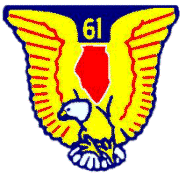 MAXWELL AFB. Ala. - Just what does the number 61 mean on the Illinois Wing patch? Obviously, it does not mean Illinois was the 61st wing to be formed within Civil Air Patrol. By the same token, what do the numbers on the Indiana, Michigan, New Jersey, Ohio, Pennsylvania, Rhode Island and Wisconsin wing patches signify?
MAXWELL AFB. Ala. - Just what does the number 61 mean on the Illinois Wing patch? Obviously, it does not mean Illinois was the 61st wing to be formed within Civil Air Patrol. By the same token, what do the numbers on the Indiana, Michigan, New Jersey, Ohio, Pennsylvania, Rhode Island and Wisconsin wing patches signify?
To find the answers, let's turn back the clock to 1941 and examine the plan devised by Civil Air Patrol founders. Loosely identified with the Office Civil Defense, as CAP was at the time, it was only natural that a system of unit numbering similar to the OCD's would be adopted by CAP. What evolved was a system where the first digit of a two digit number was the same as that used by the Army Corps area, hence OCD and CAP. The second digit, separated from the first by a dash, represented the state within the corps area. CAP then had a numbering system where a two digit number represented each of the CAP wings.
The answer to the initial question is: The "61" on the Illinois Wing patch signifies that Illinois was wing number 6-1 based on it being the first state in the 6th Army and OCD area. It follows that the number on the other patches enumerated were their respective corps area and state numbers. The dash was removed from the numbers as they appear on the patches for convenience.
The exception to numbering scheme was in the case of Hawaii, which was assigned the number 49-1 at the time of its formation at a later date. Incidentally, the other non-continental wings were assigned numbers in accordance with the original plan. Alaska was assigned 9-8 and Puerto Rico assigned 3-5, although they too were formed at a later date.
Squadrons were then assigned numbers in a sequential manner based up on the wing's number. Thus the second squadron to be formed in Illinois would have been 612. Note too that the dash is again removed.
The same scheme continued as relates to the assignment or serial numbers to individual senior members. The digits subsequent to the first two were sequentially assigned. The first member in the Illinois Wing would have been assigned serial number 6-1-1.
Cadet serial numbers were assigned in a manner similar to senior members except that the dashes were eliminated. The first cadet in the Illinois Wing would have had number 61-1. Again Hawaii was an exception, cadets from the pacific wing were assigned serial numbers beginning with 86.
Information provided by:
Civil Air Patrol News
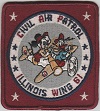
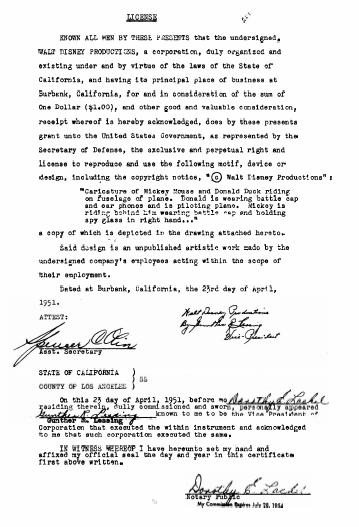

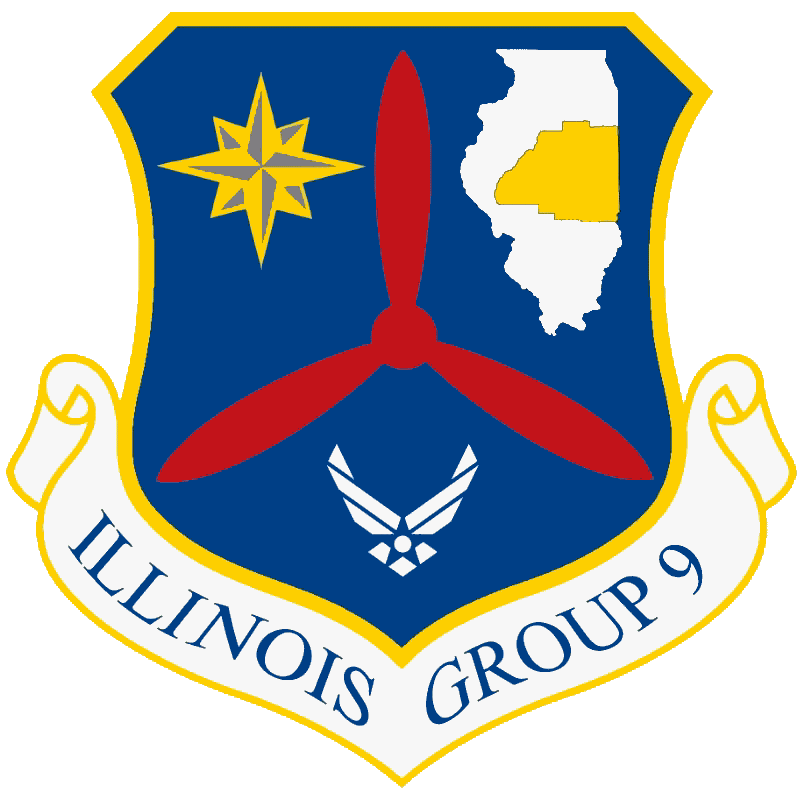 The Group 9 Headquarters patch was designed by the Group Commander, Captain Jeremy N Hendricks. It was approved for wear on September 11, 2008, by Illiois Wing Commander, Colonel Gordon Larson.
The Group 9 Headquarters patch was designed by the Group Commander, Captain Jeremy N Hendricks. It was approved for wear on September 11, 2008, by Illiois Wing Commander, Colonel Gordon Larson.
The shield design is used to represent that this unit is an Organization Headquarters, but part of a total force.
The Compass Rose is placed in the Dexter chief position to represent the Group HQ primary mission to guide the subordinate units. The gold was chosen to represent the wisdom with which the HQ guides.
The Map was chosen to represent the area of operation. The wing is colored white to represent the guiding light provided by wing. While the Group AOR is gold to represent the honor with which the group performs its missions.
The Hap Arnold wings were chosen to represent our affiliation with the United States Air Force, and white was chosen to represent the purity, truth and wisdom that the Air Force and its officer’s impart onto our membership.
All of these elements are separated by the Civil Air Patrol Propeller showing their separate and distinct missions, it is red showing the strength, courage and patriotism that is synonymous with service in the Civil Air Patrol. But they are all
bound by the all blue field representing the devotion with which all these missions are performed.
Original heraldry release from the unit: PDF
Information provided by:
Capt Jeremy N Hendricks, IL-009 Commander
September 15, 2008

I am not certarn when the patch was designed, or by whom. The winged torch in the top left quadrant represents learning: all officers and cadets must embrace the pursuit of lifeelong learning in order to succeed and best serve their fellow citizens. The lightning bolts can be taken to represent CAP communications and also lightning-fast response, which our unit strives for whenever called upon. The propeller signifies that we are a flying squadron. The Hap Arnold wing-and-star emblem in the center honors our association with the United States Air Force.
Information provided by:
Captain Jeffrey Gustafson, Commander, Springfield Comp Sq
April 23, 2010

The colors and symbols included in the design of the squadron patch each have a specific meaning:
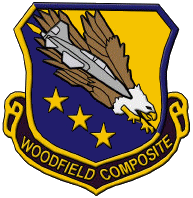
Information provided by:
Captain S A Snyder
March 15, 2005

Blazon
On a disc Azure, the propeller Gules Fess Point, outlined Sable; Triparted, Dexter Chief the symbols of our unit’s namesake, the Mercury Rocket Couchant in Sable, detailed and outlined Argent, surmounted by the Greek Symbol Mercury Sable; Sinister Chief - a Search Aircraft Soaring Right Bank, Superior Argent, Inferior Dark Azure, trimmed Gules; Base - the US Flag Gules, Argent and Dark Azure, Wavy, Inclined Dexter, Nimble Point, Satirize by a Parade Rifle inclined Sinister in Brown Silhouetted Argent.
Significance
The significance of the emblem begins with a light blue background which symbolizing the freedom of the American skies. The red propeller of courage and strength divides the disc into three sections aligned with the three missions of CAP. To the wearer’s right, in the first third, the Mercury Rocket and Greek symbol represent the namesake of the squadron - Col. John "Shorty" Powers, a native of Downer’s Grove and creator of the Air Force’s Office of Public Affairs who was later assigned to NASA and became the "Voice of Mission Control" during the initial Mercury and Gemini flights. The horizontal rocket represents the historical significance of the manned rocketry program and Col. Powers memory, while the Greek symbol hints at science, technology, engineering and math and indicates the challenge for excellence in all we do and living up to the expectations of Col. Power’s legacy. This section symbolizes the Aerospace Education Mission.
To the wearer’s left, in the second section, the search aircraft representative of a Cessna 182 in our corporate colors, symbolizes volunteerism and the emergency services mission. The right banking aircraft soars above a FIND and reflects positively on our unit’s air crews who stand vigilant with the desire fly the mission in order to save lives. The aircraft is also a key part of the Cadet Orientation Flight Program.
In the base third, the American Flag whose staff is crossed with a parade rifle symbolizes the cadet program, our allegiance to the American flag, and participation in cadet activities such as color guard, cadet competition and national special activities.
The black background of the shields signifies determination, while the gold lettering signifies member honor gained through hard work accompanied by wisdom provided by those in the chain of command. The grey outline signifies discretion and maturity.
History
The patch was designed in late 2013 and approved in early 2014. The designer was C/TSgt Patrick Guest who worked with our Lt Col Gerhart Gross to polish the design.
Information provided by:
Maj Edward Danley, Col Shorty Powers Comp Sq
August 18, 2024


August 30, 2007 patch request from the squadron: PDF
September 6, 2007 patch approval from Illinois Wing: PDF
Information provided by:
Scott Composite Squadron

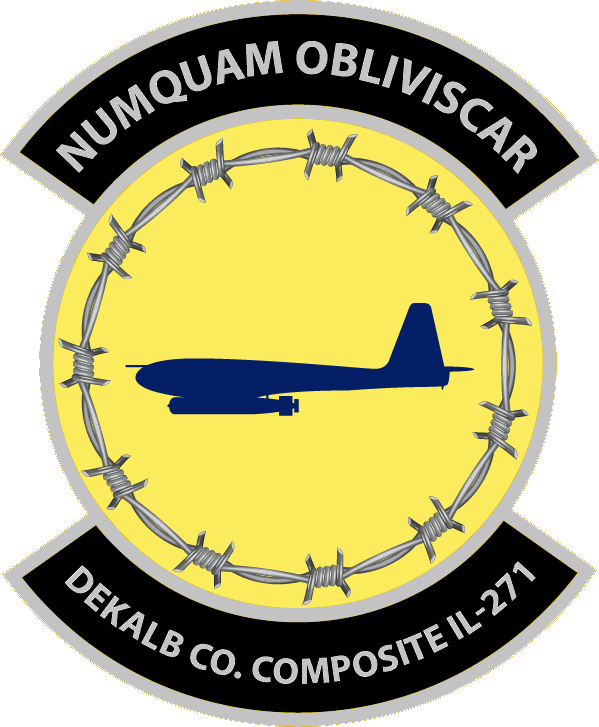
Disk: Or, bordered inside by argent barbed wire. In azure silhouette, per fess, a TDR-1 drone aircraft.
Motto: On sable scrolls, with argent letters, "NUMQUAM OBLIVISCAR", meaning 'Never Forget', referring to both the history of DeKalb County and to those US servicemen listed as missing in action.
Symbolism: The disk color, maize, represents the corn producing history of DeKalb, Illinois, where the unit is located, and denotes generosity. The barbed wire is a notable invention created in DeKalb in the 1800's and the individual barbs are to represent 11 major conflicts rgw US has been involved in. The TDR-1, manufactured in DeKalb as a joint effort between Wurlitzer and Interstate Aircraft, was the first guided missile drone ever built and is facing west to represent that pilots don't die they just fly west to forever chase the sunset. Black represents grief through the MIA flag colors, as well as it denotes strength. Azure denotes both loyalty as well as the US Navy who produced the TDR-1 drone.
Approved July 22, 2017 by:
Major Steve Weber, Commander, DeKalb County Composite Squadron
Colonel Jerry G. Scherer, Commander, Illinois Wing
Information provided by:
Captain Joanne Weber, Director of Administration, Illiois Wing
April 15, 2024

Lake in the Hills Composite Squadron Emblem Update Proposal
General Design:
Update of existing emblem (Version 1), which features many aspects of CAP (flight, communications, ground team, emergency services, etc). The existing design is in the Shield shape and needed to be updated to the "Disk with Rockers" design. The existing design was a bit "busy" and a simplification of the emblem was necessary. A motto of "Semper Virtus" was chosen and means "Always Excellent (or depending on translation, "Excellence Always"). The aircraft is a traditional Cessna 182. The proposed design incorporates two main elements of CAP; Air and Ground. The aircraft is flying in the sky but is in constant visual contact with the earth below. The ground element shows the curvature of the earth symbolizing that there is no horizon too far for CAP to help.
Base Design:
Standard "Disk with Rockers" as per an emblem for a non-headquarters unit.
Use:
Upon Wing approval, insignia will be incorporated into all letterhead, signage, and identity kits for both GLR-IL-282 (Group 22). Print use will be in keeping with CAP/USAF regulations for publication. Patch version will be created in a standard size for wear by current and future members of GLR-IL-282 in accordance with CAPM 39-1 with respect to locations for "optional" insignia on CAP uniforms. Primary wear will be on the right-breast pocket of field uniforms, and the right sleeve of flight suits.
Copyright:
Copyright will be retained by GLR-IL-282 as per CAP regulations, however license for non-commercial use will be granted to all echelons of CAP in perpetuity. There is no intention to allow commercial use of this insignia in any form.
Colors / Components
Background (sky):
Light blue signifying peace and tranquility. This portion of the emblem represents CAP's origins of serving in the skies.
Rockers:
USAF blue.
Motto:
"Semper Virtus" is Latin and translated means "Always Excellent" or "Excellence Always".
Aircraft:
Graphic representation of a typical Cessna 182 search aircraft with CAP striping.
Landscape:
USAF blue. Graphically depicting the curvature of the earch and denotes the "ground" aspect of CAP's search and rescue mission.
Information provided by:
Major John Paul Kilanski, Group 22

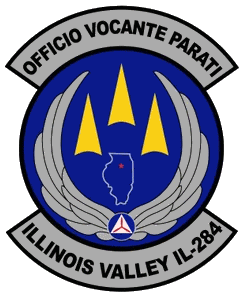 Blazon
Blazon
On a disc azure with a diminutive border sable, outstretched wings on base argent with the Civil Air Patrol emblem proper and outline of the state of Illinois on nombril point argent; three darts chiefly or. Attached above the disc: OFFICIO VOCANTE PARATI inscribed on a scroll argent with letters sable. Attached below the disc: ILLINOIS VALLEY IL-284 inscribed on a scroll argent with letters sable.
Significance
The blue background represents the sky, as well as the blue of the United States Air Force uniform Civil Air Patrol wears and the ideals that officers wearing that uniform should strive to attain. The silver up-swept wings represent swiftness and protection. The traditional CAP logo represents and honors the past members of CAP. The three chevrons represent the primary missions of Civil Air Patrol; Emergency Services, Aerospace Education and Cadet Programs. The yellow color refers to the excellence required of Civil Air Patrol personnel while executing these missions. The grey scrolls represents our willingness to serve our community. They also contain the name of our squadron, and our motto: Offiicio Vocante Parati, which means "Ready When Called". The black border represents the darkness of the night when we carry out most of our search and rescue missions as well as the determination of our members.
The emblem was designed by First Lieutenant Dan Nelson. The patches were received by the squadron August 10, 2010.
Information provided by:
1st Lt Dan Nelson, IL-284
June 15, 2010

 Heraldry
Heraldry
History
The 286th Composite Squadron was chartered in October 1977. It quickly gained a reputation as one of the Illinois Wing's top ground teams. Over the course of years, it was noticed that over 95 percent of actual missions that they were called upon were during the hours of darkness. Hence, they were dubbed 'the Black Knights' for they never failed to respond to a call for help. The patch was designed by the squadron's commander and founder, Captain Lawrence O 'Larry' Sitton, and approved by Illinois Wing Commander, Col Mel Kristmann, in May 1985. The reputation of the squadron grew and the meaning of 'A Black Knight' took on an added dimension. It came to symbolize the character traits the squadron tries to instill in its cadets: TRUTH, HONESTY, keeping ones WORD, HELPFULNESS, and ABOVE ALL... HONOR.
The words 'ABOVE ALL... HONOR' became the squadron motto and were addded to the unit patch in 1994.
Information provided by:
286th Composite Squadron

"Three golden rays are the three missions of the Civil Air Patrol: Emergency Services; Aerospace Education; Cadet Training. The red background is the strength of our membership which stands behind out missions. The focus of our united efforts is the gold disk of humanity. Organizational continuity from the past to the future is included with the historical Civil Air Patrol symbol. These elements are bounded and protected by the blue of squadron fidelity, loyalty, and truth."
Information provided by:
Philip R Kesler
December 1995